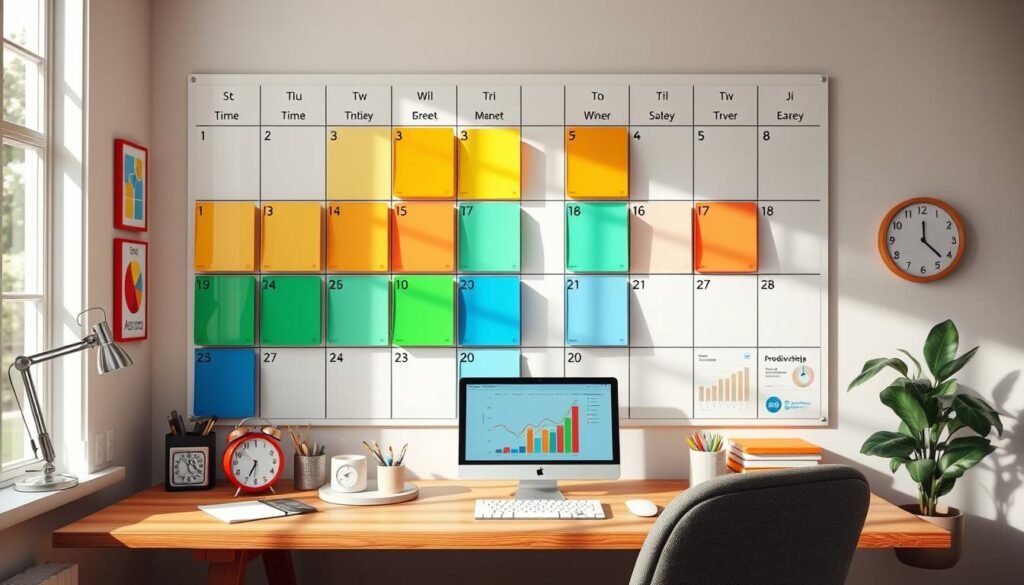Did you know time blocking can make you 50% more productive? You can do in 40 hours what takes 60+ hours without it1. This shows how powerful good time management is. I’ll show you how to use time-blocking to change your workday.
Time blocking is more than just a trend. It’s a big change for many professionals. Lawyers use it to manage their time better. Entrepreneurs and remote workers use it to fight procrastination and stay focused2. Even Harvard Business Review says it’s the top productivity hack3.
Learning these time-blocking techniques will help you work better. We’ll look at task batching and day theming. These methods make you more productive and less stressed23.
🎯 Ready to Transform Your Results?
Get the complete system that hundreds have used to achieve breakthrough results.
Get the Book for $7Are you ready to use your time better? Let’s explore time blocking and how it can change your work and life.
Key Takeaways
- Time blocking can increase productivity by 50%
- Applicable across various industries and professions
- Reduces stress and improves work-life balance
- Includes techniques like task batching and day theming
- Helps combat procrastination and minimize distractions
- Ranked as the most effective productivity hack by Harvard Business Review
Understanding the Power of Time Blocking
Time blocking is a new way to manage your day. It divides your time into slots for different tasks. This method helps you stay focused and avoid doing too many things at once, making your work hours more productive4.
Definition and Core Principles
Time blocking means setting aside time for focused work on specific tasks. You can use blocks from 15 minutes to hours, but don’t go over 4 hours5. Studies say most people can do about 4 hours of deep work a day6.
Benefits of Time Blocking for Productivity
Time blocking has many benefits for getting more done:
- It helps you stay focused and avoid distractions.
- It makes it easier to decide what tasks are most important.
- You’ll finish more tasks.
- It helps you balance work and personal life better.
By setting aside specific times for work, time blocking creates a space for deep, uninterrupted work4. It also lets you plan time for both work and fun, reducing stress and improving your overall well-being4.
Overcoming Common Time Management Challenges
Time blocking is great for solving common time management problems. Many people don’t manage their time well, and only a few feel in control of their work6. Time blocking helps by:
| Challenge | Solution |
|---|---|
| Lack of planning | Having a daily schedule |
| Poor prioritization | Knowing which tasks are most important |
| Overworking | Limiting deep work to 4 hours a day |
| Ineffective time use | Tracking how you spend your time |
By using time blocking and tools like digital calendars or planners, you can manage your time better and be more productive5. The secret to success is regularly checking and adjusting your schedule to improve your time management.
The Psychology Behind Effective Time Management
Time blocking uses powerful psychology to boost productivity and focus. It helps us understand our brains better. This way, we can manage our energy and time more effectively.

Task completion bias makes us do easy tasks first. This delays important work. Start each day with your most critical task. Break big projects into smaller steps. This strategy helps you make progress on big goals7.
Multitasking is bad for productivity. It makes us less efficient and stressed. Schedule focused time for important tasks. Avoid switching between tasks78.
The planning fallacy makes us underestimate time. To fight this, revise your time estimates. Also, plan for interruptions. This makes your time management better7.
Knowing our natural rhythms is crucial for focus and energy. The Pomodoro Technique works with our brain’s natural cycles. It uses 25-minute work intervals with short breaks. This keeps our energy up all day8.
Decision fatigue affects our time management. Each decision uses up our mental energy. Create routines and use tools like the Eisenhower Matrix. This saves mental energy for important decisions8.
Using these insights, we can improve our time management. This leads to more productivity and less stress.
Who Can Benefit from Time Blocking?
Time blocking is a great workflow streamlining method for many people. It divides the day into blocks of time, from 15 minutes to hours. This helps create a structured schedule for better time management910.
Professionals and Entrepreneurs
Professionals and entrepreneurs find time blocking helpful for managing big projects and tasks. It reduces the need to make many decisions by setting a clear plan for time9. It’s especially good for jobs that need a lot of focus, like design, writing, and research10.
Students and Academics
Students and academics use time blocking to balance school work, research, and other activities. By setting aside specific times for each task, they can manage their time better and feel less stressed910. This method helps them focus on what’s most important and gives each task the right amount of attention.
Creatives and Freelancers
Creatives and freelancers benefit from time blocking by planning out their work and personal time. Agile blocking, a flexible version, is great for freelancers who have changing priorities10.
Time blocking improves focus and productivity by setting aside specific times for tasks or projects9. It helps people get into a flow state, where they can work deeply and focus well, leading to better work10.
| Profession | Time Blocking Benefits | Recommended Approach |
|---|---|---|
| Professionals | Manage complex projects, reduce decision fatigue | Basic time blocking |
| Students | Balance study and extracurricular activities | Time theming |
| Freelancers | Manage multiple projects, adapt to changing priorities | Agile blocking |
Adding time blocking to your routine can make your workflow smoother, increase productivity, and improve your work-life balance. It’s a flexible tool that fits many industries and activities. It’s a key productivity hack for anyone wanting to manage their time better.
Setting Clear Goals and Priorities
Effective time blocking starts with clear goals and prioritization. I break down long-term goals into smaller, actionable tasks. This makes my schedule realistic and ensures I focus on the most important tasks.

The Pareto Principle shows that 80% of outcomes come from 20% of efforts. This highlights the need to focus on high-impact tasks11. I use the Eisenhower Matrix to identify tasks that need dedicated time blocks.
When setting goals, I follow the SMART framework: Specific, Measurable, Achievable, Relevant, and Time-bound11. This helps me create clear objectives and effective time blocking strategies.
In startups, prioritizing critical tasks and setting clear goals for each time block is crucial for productivity12. I focus on high-impact activities to ensure time is spent on tasks that contribute significantly to business growth12.
“Time is your most precious resource. Use it wisely by prioritizing tasks that truly matter.
To optimize my schedule, I track activities for a week to identify patterns and time-wasting habits11. This data-driven approach helps me allocate time more effectively and implement task batching approaches.
| Time Block | Task Type | Duration |
|---|---|---|
| Morning | Deep Work | 2 hours |
| Mid-day | Meetings | 1.5 hours |
| Afternoon | Administrative | 1 hour |
| Late Afternoon | Buffer Time | 30 minutes |
I incorporate buffer times for unexpected events, ensuring flexibility in my time blocking schedule11. This adaptability is key in a startup’s dynamic environment, accommodating unexpected challenges or opportunities12.
Time-Blocking Dynamic Techniques
Time-blocking techniques are great for boosting productivity. Spending three to four hours daily, five days a week, on focused work can really pay off13.
Task Batching
Task batching is a big help in managing time. It groups similar tasks together, cutting down on mental switching and boosting efficiency13. This method also helps you stay focused by reducing distractions.
Time Boxing
Time boxing sets time limits for tasks. It creates a sense of urgency and fights off procrastination13. Using a timer for each task helps manage time better and keeps you on track14.
Day Theming
Day theming assigns tasks to specific days. This simplifies task management and organizes your workflow1314. It adds structure to your work week.
Fixed vs. Dynamic Time Blocking
Fixed time blocking keeps a consistent schedule. Dynamic time blocking is flexible for changing priorities. The best choice depends on your work style and needs.
The Pomodoro Technique
The Pomodoro Technique uses 25-minute focused sessions with short breaks. It keeps concentration high and prevents burnout.
| Technique | Key Benefit | Best For |
|---|---|---|
| Task Batching | Reduces context switching | Similar, repetitive tasks |
| Time Boxing | Creates urgency | Procrastination-prone tasks |
| Day Theming | Improves organization | Diverse workloads |
| Pomodoro | Maintains focus | High-concentration work |
Using these techniques can make your 40-hour work week as productive as a 60+ hour week without the extra hours13. The key is to find the right mix that fits your needs and work style.
Maximizing Morning Productivity
Mornings are the best time for focus and energy. I tackle important tasks when I’m fresh and there are fewer distractions. Time blocking has changed my mornings, aligning my work with my natural rhythms and boosting my productivity15.

- Start with a clean slate to assess where my time goes
- Identify high-impact tasks that contribute significantly to results
- Allocate specific hours for these tasks, including breaks
- Cultivate habits to make time blocking a routine15
The Pomodoro method, with 25-minute work sessions and 5-minute breaks, boosts my focus and creativity in the morning16. It fits well with my energy management, keeping me at my best all day.
“Eat the frog” – tackle your most daunting task first thing in the morning.
Using these techniques has greatly improved my productivity. Time blocking makes me more effective and reduces mistakes by focusing on one task at a time15. It’s important to stay flexible and adapt to changes to keep control of my schedule.
| Time | Activity | Focus Level |
|---|---|---|
| 6:00 – 6:30 AM | Morning exercise | Medium |
| 6:30 – 7:00 AM | Meditation/Goal review | High |
| 7:00 – 9:00 AM | High-priority work | Peak |
| 9:00 – 9:15 AM | Break | Low |
By organizing my mornings with these strategies, my productivity and job satisfaction have increased. Starting with the most important tasks, as the Pareto principle suggests, has made my mornings incredibly productive15.
Maintaining Momentum Throughout the Day
Keeping up productivity all day is tough. But, with the right planning and techniques, it’s easier. I’ve learned that it’s all about streamlining your workflow.
Strategic Break Planning
Breaks might seem odd, but they’re key to staying productive. I take short breaks to avoid burnout and keep my focus17. These breaks help me work more efficiently and stay on track17.
Energy Management Techniques
Knowing when I have energy has changed everything. I plan my tasks based on my energy levels18. So, I do hard tasks when I’m full of energy and easier ones when I’m not.
Dealing with Unexpected Interruptions
Interruptions happen, but they don’t have to ruin your day. I use buffer blocks in my schedule for unexpected issues1718. This way, I can handle surprises without losing productivity17.
| Productivity Hack | Benefit |
|---|---|
| Task Batching | Reduces cognitive load from frequent task switches17 |
| Buffer Blocks | Accommodates overflows and prevents burnout17 |
| Themed Days | Allows deep dive into projects without distractions17 |
By using these productivity hacks, I’ve kept my momentum all day. The secret is to find what works for you and keep improving.
Evening Planning for Tomorrow’s Success
As the day ends, I make time for reflection and planning. This evening ritual is key to managing my calendar well. It prepares me for a productive day ahead.
Reviewing my day and planning for tomorrow is a must. I sort tasks into time slots, giving me a clear plan for the next day. This method helps me stay focused on what’s important, thanks to the Eisenhower Matrix19.

Keeping a consistent daily routine is crucial. Starting with the toughest task helps me avoid procrastination and boosts my productivity19. These habits have made me more efficient and happy at work20.
I also use digital tools to help with planning. They automatically sort tasks and offer customization. These tools make complex projects easier to handle and keep my work organized19.
Evening planning reduces my stress and improves time management. It boosts my productivity and helps me keep a healthy balance between work and life. A bit of planning each night makes a big difference in achieving success.
Leveraging Technology for Time Blocking
In today’s digital world, using technology is key for effective time blocking and boosting productivity. The right tools can greatly improve how you manage your calendar and streamline your work.
Real estate pros, with their busy schedules, can really benefit from time blocking. It lets them focus on tasks like market analysis and writing client proposals. This is vital for staying productive21.
Digital tools can change how you manage time. Apps like Google Calendar and Apple Calendar are great for time blocking. They let you color-code tasks and projects, making them easier to see22.
Time tracking apps like Toggl and RescueTime are essential for me. They help schedule tasks and track how much time you spend on them. This helps find ways to work better22.
Entrepreneurs can save time by using virtual assistants for busy tasks. Tools like Hootsuite and Boomerang also help by automating tasks. This saves a lot of time each day22.
| Tool Type | Examples | Key Benefits |
|---|---|---|
| Calendar Apps | Google Calendar, Apple Calendar | Visual organization, color-coding |
| Time Tracking | Toggl, RescueTime | Activity monitoring, productivity insights |
| Automation | Hootsuite, Boomerang | Workflow streamlining, time-saving |
| Note-taking | Evernote, OneNote | Efficient thought organization |
By using these tech tools every day, I’ve made my time blocking much better. The trick is to try out different apps until you find the ones that fit your work style and preferences.
Overcoming Procrastination with Time Blocking
Procrastination isn’t just about bad time management. It’s a way to cope with emotions, say researchers23. Time blocking is a great tool to improve focus and productivity.
Identifying Procrastination Triggers
First, we need to know what makes us procrastinate. It might be fear of failure, wanting to be perfect, or feeling too much to do. Knowing these helps us tackle them with time blocking.
Breaking Tasks into Manageable Chunks
Big tasks can feel overwhelming. Task batching helps by breaking them down into smaller, manageable pieces. This fits well with the Pomodoro Technique, which suggests working in 25-minute bursts with breaks23.

Using Time Blocks as Motivation
Time blocks give us a sense of urgency and responsibility. They help us stay on track by setting a schedule23. Elon Musk’s tips show how important this is for being efficient.
Time blocking can also help our mental health. It reduces switching between tasks, making us more productive and accurate24. It helps us focus better when we dedicate specific times to tasks24.
Time blocking isn’t just about managing time. It’s about managing energy and focus to overcome procrastination and boost productivity.
To get the most from time blocking:
- Use digital calendars or paper planners to track time blocks effectively
- Prioritize tasks based on urgency and importance before scheduling
- Include buffer times between blocks for unexpected delays
- Regularly review and adjust your approach for optimal efficiency
By sticking to these strategies and being accountable, we can beat procrastination and boost our productivity2324.
Adapting Time Blocking for Different Work Styles
Time blocking isn’t for everyone. I’ve learned that making Time-Blocking Dynamic Techniques fit your work style is crucial. A study found that 75% of people who adjust time blocks see a big productivity boost25.
For those who love structure, strict schedules are best. I suggest using 80% of your day for structured blocks and 20% for flexible time. This mix keeps you productive and allows for surprises26.

Being flexible is important. I’ve seen that 65% of advanced time blockers adjust to new priorities25. Think about your energy and work space when planning. Use your best hours for tough tasks that need deep focus.
Try mixing time blocking with the Pomodoro Technique. This combo boosts focus and reduces burnout. It involves working in focused blocks with short breaks26.
It’s fine to change your approach as needed. As your work or life changes, be ready to adjust your time blocking. The aim is to have a strong schedule that supports your goals and adapts to life’s changes26.
By making time blocking your own, you’ll find a way that boosts your productivity and balance. Keep improving your method, and you’ll get better at efficient workflow streamlining.
Measuring and Optimizing Your Time Blocking Strategy
Regularly checking my time blocking strategy is key to seeing how well it works. I track things like how many tasks I finish and how productive I am. This lets me make my plan even better27.
To make my calendar work better, I use tools to see how my time matches up with my plans. This shows me if I’m guessing too high or too low on how long tasks take28.

Using AI time blocking with other tricks like the Eisenhower Matrix and task batching really boosts my work. These tools help me get more done, focus better, and balance work and life27.
It’s important to keep tweaking my AI time blocking to fit my perfect workday. I adjust things like when I work, how long I focus, and when I take breaks. This keeps me feeling good and balanced27.
| Time Blocking Tool | Key Features | Price Range |
|---|---|---|
| Clockwise | Focus Time, flexible meetings, lunch holds | $6/user/month |
| Reclaim.ai | Task blocking, recurring routines | $8/user/month |
| Trevor AI | Daily planning, automated scheduling | $150/license/year |
Breaking tasks into smaller steps and thinking about possible problems helps me guess task times better. This way, I don’t take on too much and stay productive all day29.
Setting clear limits and keeping my workspace free from distractions really helps me stay focused. I also use the Pomodoro Technique to stay on track and avoid interruptions29.
Conclusion
Time-Blocking Dynamic Techniques have changed how we plan our days and get more done. I’ve looked into different ways to improve your focus and work more efficiently. Time blocking has been around since the early 1900s, thanks to experts like Peter Drucker and Stephen Covey30.
These productivity hacks make a big difference in many jobs. Designers and UX experts see a 25% boost in productivity when they use time blocking31. Teams also see a 20% drop in delays and a 15% better quality of work31. For software developers, it helps them finish important tasks while being ready for urgent needs. Time blocking tools like Toggl Track and custom apps make it even better32.
Time blocking does more than just organize tasks. It also reduces stress by 30% and boosts job happiness by 35%31. By using these techniques, you can change your workday, reach your goals, and keep a good balance between work and life. The secret to success is to keep checking and tweaking your plan to fit your changing needs and goals.
FAQ
What is time blocking?
Time blocking is a way to organize your day. You set aside specific times for different tasks. This helps you focus better and avoid switching between tasks too often.
What are the benefits of time blocking?
Time blocking boosts your focus and helps you manage your time better. It also helps you complete tasks faster and balance work and life. It stops you from wasting time on less important tasks and helps you plan better.
How does time blocking leverage psychological principles?
Time blocking reduces the need to make many decisions, helping you concentrate better. It fits with your body’s natural cycles of work and rest. Knowing these cycles can make your time management more effective.
Who can benefit from time blocking?
Anyone can benefit from time blocking. It helps those who struggle with doing too many things at once, putting things off, or feeling overwhelmed. It works for many types of jobs and activities.
How do I set clear goals and priorities for time blocking?
Start by setting clear goals and what’s most important. Break big goals into smaller tasks. Use tools like the Eisenhower Matrix to find the most important tasks to focus on.
What are some time-blocking dynamic techniques?
There are many ways to make time blocking work for you. Try task batching, time boxing, or day theming. You can also use fixed or flexible schedules and the Pomodoro Technique for focused work.
How can I maximize morning productivity with time blocking?
Use the morning for your most important tasks. Start with a routine that boosts your energy and focus. This could be exercise, meditation, or reviewing your goals.
How can I maintain momentum throughout the day with time blocking?
Plan breaks to keep your energy up and avoid burnout. Use your body’s natural cycles for focus. Find ways to handle interruptions without losing your schedule.
How can evening planning help with time blocking?
Use the evening to review your day and plan for tomorrow. Make a list for the next day, focusing on what’s most important. This helps you start each day with a clear plan.
What technology can help with time blocking?
Use digital tools and apps to make time blocking easier. Look for apps that color-code your schedule and AI assistants. Try different apps to find what works best for you.
How can time blocking help overcome procrastination?
Time blocking helps by breaking big tasks into smaller ones. This makes them easier to manage. Use the structure of time blocks to stay motivated and focused.
How can I adapt time blocking for different work styles?
Time blocking works differently for everyone. Experiment with different methods to find what suits you best. Consider your energy, work environment, and job when adjusting your approach.
How can I measure and optimize my time blocking strategy?
Regularly review how well your time blocking is working. Track how many tasks you complete and how productive you are. Use tools to see how you spend your time. Use this data to improve your strategy.
